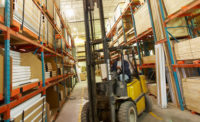Review forklift safety checklists every day

Credit: Getty Images
The job of a forklift operator is not an easy one. It comes with many concerns to be aware of – and safety should be at the top of the list. Training is a vital element to make this happen. And it has been proven that the proper training of forklift operators is key to effective forklift safety.
OSHA maintains standards for forklift safety. This facet of vehicle safety is a key issue for those operating powered industrial trucks (forklifts) on a daily basis. It’s also a priority for owners who will want to avoid the cost of accidents and potential fines for misuse of forklifts. In addition to its standard, OSHA also provides forklift training programs and safety checklists.
The tipping of forklift vehicles accounts for approximately 42 percent of forklift fatalities, due to the operator being crushed. Many injuries have ensued from not using the seatbelt. According to OSHA, operators of powered industrial trucks are obligated to use a restraint or seatbelt. OSHA also has the ability to fine a company, which can cost up to $7,000 for “minor” infractions and up to $70,000 for repeat offenders.
Best practices for forklift safety
Checklists for forklift operators play a vital role in daily forklift use and, unfortunately, can be easily overlooked. It is helpful to make using forklift checklists a habit with operators just as they would in strapping their seatbelt in their car. Safety can be greatly impacted and equipment compromised when operators cannot be bothered with taking the time to check over even the most basic of forklift components and functionality. It can be as simple as the operator checking tires, the battery, blinkers, horn, steering, braking and travel controls.
From a maintenance perspective, it is helpful to break the checklist down into categories:
• Under the hood: Operators should be sure to check the motor oil, brakes, hoses, power steering, coolant level, batteries, fuel line leaks belt tensions, and fuel level.
• Interior category: Check the steering, mirrors, clutch, horn/safety devices, meters and gauges/controls.
• Exterior category: Forklift operators should check tires, wheels, lug bolts, hydraulic reservoirs, hydraulic lines, stoplights, head- and tail-lights, directional signals, warning lights, steering mechanism, drive line, universal joints, ROPS (rollover protection system), forks, propane tank, and coupling devices
• General category: Check the exhaust system, engine, fire extinguisher, slow moving triangle and first aid kit.
Preventing forklift accidents
Some suppliers to the forklift industry look to meet or exceed OSHA’s standard. One example is a new line of tires. A discernable orange line appears on the tire when the forklift tire is 100 hours from the end of its lifecycle. This enables forklift operators and maintenance personnel to plan for downtime as well as to avoid potential safety issues with a forklift tire still on the warehouse floor when it should no longer be in use.
Features in one line of forklifts include safety devices such as overhead guards, operator restraint systems, manually operated horns, skid resistant entry/exit steps, operator assist grips and ergonomic placement of hydraulic controls.
Paying the price
The hope is that by strengthening safety initiatives, the industry will see a decrease in OSHA statistics, which are reporting approximately 85 forklift fatalities and 34,900 serious injuries yearly.
According to the National Safety Council, the average direct cost to a company for a forklift incident is $38,000 -- with $150,000 in indirect costs. Thus far, innovations such as this are catching the attention of the industry - especially in the wake of injuries caused by forklift accidents.
|
Age limit It is a violation of Federal law for anyone UNDER 18 years of age to operate a forklift or for anyone OVER 18 years of age who is not properly trained and certified to do so. What are the hazards of operating powered industrial trucks? There are many types of powered industrial trucks, according to an OSHA fact sheet. Each type presents different operating hazards. For example, a sit-down, counterbalanced high-lift rider truck is more likely than a motorized hand truck to be involved in a falling load accident because the sit-down rider truck can lift a load much higher than a hand truck. Workplace type and conditions are also factors in hazards commonly associated with powered industrial trucks. For example, retail establishments often face greater challenges than other worksites in maintaining pedestrian safety. Beyond that, many workers can also be injured when (1) lift trucks are inadvertently driven off loading docks; (2) lifts fall between docks and an unsecured trailer; (3) they are struck by a lift truck; or (4) they fall while on elevated pallets and tines, according to OSHA. |
Looking for a reprint of this article?
From high-res PDFs to custom plaques, order your copy today!






